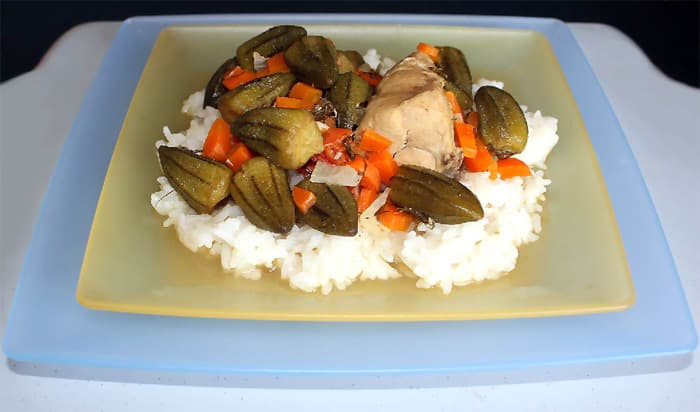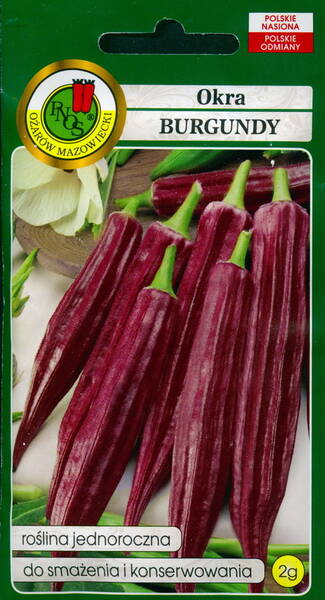Unique delicate taste!
A very interesting annual vegetable culture.
It grows quickly: it begins to bear fruit already 55-65 days after germination and continues to bear fruit until the first frost.
The plants are powerful, exotic in appearance; in the middle zone they grow up to 120-150 cm (in the southern regions - up to 200 cm).
Young 3-6 day old ovaries (pods) weighing 10-30 g each are eaten. Yellow flowers with red spots on the petals grow from the axils of the leaves in the summer. The fruit is a finger-shaped capsule up to 30 cm long, burgundy in color. The fruits are harvested when they are still unripe and soft. They can be boiled, fried, stewed, dried, pickled and canned.
The fruit has an unusual taste: somewhat reminiscent of eggplant and asparagus, but more delicate and piquant. They are used fresh in salads, for making soups and side dishes.
Okra fruits are low in calories, so they are good for dietary purposes.
1.0 g = 15-18 seeds.
Agrotechnical culture.
In Estonian conditions, it is better to grow bamia through seedlings.
Seeds germinate slowly - 2-3 weeks. It is better to sow immediately in peat pots, as this culture does not tolerate transplantation well.
The optimum temperature for growing seedlings is +18+21°C.
Seedlings are planted in open ground when spring frosts have passed (for Estonian conditions, approximately after June 10).
Seedlings are planted at a distance of 40 cm between plants, with a row spacing of 70 cm.
The plant needs pinching. Plants bloom about two months after germination, and after five days it is already possible to start picking fruits. They do this regularly - every 3-4 days, when the boxes reach a size of 4-6 cm.
Okura loves sunny places and light fertile soil.
Care is regular watering. Fruiting continues until frost. The ovaries are cut or broken out regularly, every 3-4 days. If there is a delay in picking, the fruit boxes become coarse and become inedible.

Ocra is an annual vegetable crop, a herbaceous plant. Okura resembles a shrub: covered with stiff hairs, a thick, rough stem is branched at the base.
The leaves of the gumbo are large, dark green, seven-lobed, covered with hard fluff. Solitary large cream-colored flowers with a purple spot in the middle, blooming in the axils of the leaves.
The fruits of bamia are somewhat vaguely reminiscent of peppers: elongated green pods covered with hairs.
Gumbo is very fertile: ripe pods are harvested every 3-4 days until the end of the harvest season. From one bush, you can cut 5-10 pods at a time.
The taste of this plant is surprisingly similar to eggplant and asparagus, hence the methods of preparing ocra, which are identical to the methods of preparing these products.
But ocra is not only fried and stewed, it can also be eaten raw in various salads. Soups, snacks, meat and vegetable dishes are prepared with okra. As a side dish, it goes well with fish, poultry and meat.|
Bamia seeds are also a gastronomically curious product: they are roasted and used instead of coffee, and a specific hot drink is brewed with them. In addition, okura seeds are used to squeeze oil, which is rich in unsaturated fats and has a delicate pleasant aroma. Bamia (okura) leaves are used in salads and soups.
Agrotechnics of bamia (gumbo, okura, okra).
Ocra is best grown through seedlings. Seeds germinate slowly - 2-3 weeks. It is better to sow immediately in peat pots, as this culture does not tolerate transplantation well.
The optimum temperature for growing seedlings is +18+21°C. Seedlings are planted in open ground when spring frosts have passed (for Estonian conditions, approximately after June 10).
Seedlings are planted at a distance of 40 cm between plants, with row spacing of 70 cm. Plants bloom about two months after germination, and after five days you can already start picking fruits.
They do this regularly - every 3-4 days, when the boxes reach a size of 4-6 cm. Ocra loves sunny places and light fertile soil.
Care is regular watering. Fruiting continues until frost. Due to the high content of mucous substances in okra fruits, okro dishes are useful for the prevention and treatment of various diseases of the gastrointestinal tract. It has also been noticed that okra helps to restore exhausted body forces after hard physical work or a long illness.
Eng.: Okra, Gumbo, Lady fingers, gambo, gombo, okura, ocra, bamia ochro, bhindi, bombo, chimbombo, Bhindee, Bhindi, Bindi, Cantarela, Gombaut, Bumbo, Mesta, Ochro, Okro, Quiabo, Quimbambo, Quingombo, Rosenapfel, Vendakai, qiu kui, okura. Bot. syn.: Hibiscus esculentus.
* Due to the high content of mucous substances in okra fruits, okra dishes are useful for the prevention and treatment of various diseases of the gastrointestinal tract. It has also been noticed that okra helps to restore exhausted body forces after hard physical work or a long illness.












